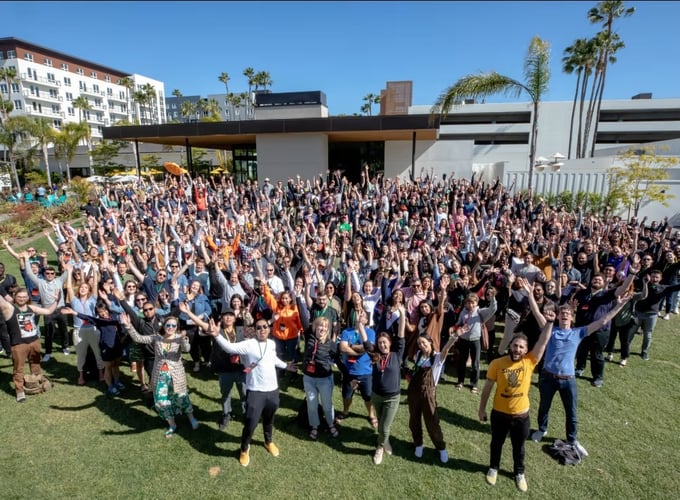Finding a company with the best culture is hard enough, but it can be extra challenging at remote companies. Getting a sense of a remote company's culture can be tricky when you're not actually there to witness it in person.
When you don't get a chance to tour the office and see people working, or see up close how people interact with one another, then how do you get a feel for a company's remote culture?
.jpg?width=1200&height=800&name=remote%20culture%20(1).jpg)
During the interview process, even virtually, there are several "green flags" you can spot that indicate a positive company culture. These could be written in company polices, seen in examples of how people interact, or even something you notice in the recruiting process.
Here's what to look out for — and how to ask about it if it doesn't come up.
Green Flags To Look For In A Remote Company Culture
1. Using communication platforms — with set expectations
Getting a remote team on the same page can be tricky, but it's one of the most important things. Companies that work hard to prioritize open communication and transparency have can have a great remote culture — no one wants to feel like they're in the dark.
On the other hand, no one wants to feel like they're expected to be online all the time. What do you do if you're not working but you get a Slack message at 8pm? Make sure they have the communication tools set up for success as well as the expectations set for when and how to use them.
Question to ask: Tell me more about how the team communicates while working virtually? What are the expectations for when employees should be online and available?
2. Additional flexibility policies
Remote flexibility is great, but it's not so great if you're expected to be online for very specific hours. If a company has a strict "9 to 5 online" policy then it's not really a flexible environment, is it? If the team encourages asynchronous work, time off, and flexible hours, that's a great green flag.
Question to ask: Besides remote work, what other ways does the team encourage flexibility?
3. Wellness support and programs
Remote work can greatly impact your health — in both positive and negative ways. It can give you more time to work out, or if you're in a toxic remote environment, it can leave you feeling drained. If a company offers employee benefits that support wellness (these could be things like a gym stipend/discount, wellness days, access to mental health resources like a Boon coach, or even financial wellness like the Dolr app) then that is a great sign that they support their employees, even from a distance.
Question to ask: What kind of benefits are in place to support employee wellness, both physically and mentally?
4. Minimum PTO
Unlimited PTO sounds pretty great, until it's not. People with "unlimited PTO" tend to take less time off out of fear of looking like they're slacking off. Remote or not, if a company has unlimited PTO, the first thing you should do is just ask more questions. Ask about the policy, ask about the culture, ask how often people actually take time off and what the average yearly number is per employee. What's a really good green flag for remote culture is "minimum PTO." If a company has an unlimited vacation policy that includes a minimum, this means they are serious about people taking the time off they need. They have a culture that encourages time away from work, and being fully off.
Question to ask: For PTO, is there a minimum numbers of days that employees aim for? On average, how many days to people actually take off?
5. Results-oriented
If a company is "results-oriented" that could be a good sign that they have a great remote culture. For one, being "results-oriented" tends to imply that a company cares less about the hours and more about the performance. It's a sort of anti-"butts-in-the-seat" mindset. Results are more important than presenteeism. A culture that values performance rewards good work, so if you're doing great work, it won't matter if you need to step away for a bit, take a mental health day, or go on vacation. The team trusts you to do your work. This culture kind of culture rewards high performers and creates a culture of purpose and productivity — and balance.
Question to ask: What does success look like for employees? How do you gauge employee performance?
%20(1).jpg?width=1200&height=800&name=remote%20culture%20(2)%20(1).jpg)
6. Available and accessible leadership
One of the things that can be hard in a remote setting is getting in touch with people. When you can't just lean over and ask a question, you have to be sure there are direct lines of communication open on a distributed team. This also must apply to leadership. If managers do not make themselves available to answer questions or collaborate with, you might find yourself feeling stuck (both in your day-to-day work and in your career). If the leadership team is available, even remotely, that's a great sign they have an open and transparent culture, and one that supports employee success.
Question to ask: How do leaders make themselves available in a remote setting?
7. Employee interest groups
Community can make a huge difference at a job, especially when working remotely. Just because everyone is spread out doesn't mean that coworkers can't bond and have meaningful relationships with one another. One way to spot that is if there are employee interest groups. Maybe it's as structured as regular meetings, or maybe it's just a slack channel for #crafts. Whether it's for movie buffs, book clubs, pet parents or athletes, if there's a group bringing people together, that's a great sign. This can also give you a sense of inclusivity at the company. Are people encouraged to be a part of a community, to get to know one another? If so, that's also a great sign.
Question to ask: How do employees connect with each other on non-work things? Are there employee groups or communities?
8. Immersive Onboarding
Great onboarding is a green flag at any company, but especially for fully remote companies. If you've started a job in a totally remote setting, you know it can feel confusing and isolating. Everyone is going about their business in their own home offices while you're in your own space trying to figure out all the tools and platforms. If a company has an immersive onboarding experience, one that does not leave you in the dark and exposes you to many facets of the company, even remotely, that's a green flag.
Question to ask: What is your onboarding experience like? How do you make new remote employees feel like they're a part of the team?
9. Giving and receiving feedback
We like to say, "Feedback is a gift." And in a remote setting, it can get a little tricky if the lines of communication aren't open (see points #1 and #6). If the team embraces feedback and has a clear way of giving and receiving it, that's a green flag. Not only will you learn a ton at the company, but you'll also feel like your voice matters.
Question to ask: How do employees give and receive feedback?
With these 9 green flags, you'll be able to spot a great remote culture that fosters collaboration and community, trust and autonomy, flexibility and work-life balance, and employee well-being and support.
Remember that these green flags are not definitive proof of a good company culture, but they can serve as indicators that the company values its employees and promotes a positive work environment, even in a remote setting.
Be on the lookout for these things in your next remote interview. If it's hard to tell in the interview process, ask for the chance to talk to someone at the company, and read reviews online. If you see these green flags, it's a clear sign of a great remote culture.

.jpg?width=950&name=remote%20culture%20(1).jpg)







.png?width=50&name=Erin%20Gregory%20(1).png)

